QuestionHello Nikole,
I have two fresh water tanks. One is 120 gallons and other is 25. I had them for almost 7 years. And all this time it seems very stressful to keep up with having beautiful and clean water. It would stay nice and clean for a while, but then something happens and the fish would start to get sick and die, or water gets nasty and cloudy. And whatever I do, it just not working... In the big tank we have only one fish,that survived in 7 years. But it got so huge, (almost 18" and unfortunately I don't know what kind of fish is it: my husband bought it in pet store and forgot what it was called, and since that time we never see fish like ours)so we can only keep one fish in that tank. And now the water gets very high in alkalinity, that poor thing is suffering. For almost the whole week I was treating the water with "Ammo-luck-2", and some water conditioner, and about 20% of water changes, but the level of alkaline is steal the same.The fish seems to have a trouble breathing now, even I have two very big air stones inside. I also have under gravel filtration system, regular filters with extra bacterial filters inside. What else can I do???
My other aquarium is also very cloudy now. And it been this bad for almost a month. The alkalinity and pH tests are good, fish seems to be happy, but I cannot see for more than couple of inches inside. Tried to treat the water with "Water Clear", adding extra dose, but it still the same. In that tank we have only two little barbs and algae eater.
Please, help me!!!
AnswerGood morning Elena, thank you for your question.
I definitely know what your problem is, but first, let's discuss that 18" fish! I'd love to see a picture and help you ID it, if you could send me an e-mail at platytudes (@) gmail.com I'd be happy to take on the challenge. Remove the ( ) of course, I put those there to avoid getting spammed.
Let's start from the very beginning. Read here, all of it:
http://freshaquarium.about.com/cs/biologicalcycle/a/nitrogencycle.htm
Then, let's talk about the values on your test kit. When you test your water, here's what you should be seeing:
* Ammonia = 0 ppm. Ammonia is the first step in the nitrogen cycle. It never shows up in a healthy, cycled tank.
* Nitrite = 0 ppm. Nitrite is the second step in the nitrogen cycle. Beneficial bacteria break down ammonia into this substance. It's less harmful than ammonia, but still toxic. Again, it never shows up in a healthy, cycled tank.
* Nitrate = less than 20 ppm. Nitrate is the end product of the nitrogen cycle. After ammonia is converted to nitrite, another kind of beneficial bacteria converts nitrite to nitrate, with an A. This level is relatively harmless to fish at low levels, it should ideally be kept as low as possible. My tanks have nitrate levels of between 5-10 ppm. Nitrate is still toxic at high levels (40 ppm or more).
Unless the pH is high or low in the extreme, there is no reason to be concerned with what it is exactly. I live in Florida, so mine is over 7, a bit on the high side - 7 is a neutral pH. Blackwater fishes like discus like a low pH, in the low 6s. Cichlids from the Rift Lakes such as Africans, like a higher pH, in the 8s. Your pH should be somewhere between 6 and 8, if it's much higher either way, I would investigate why. In some parts of the country, folks have a pH as high as 9, so do be aware of your pH, but unless it's at an extreme, do not make attempts to tinker with it!
Now here's the part that directly relates to what you said, Alkalinity. Alkalinity is basically a measure of the "resistance" of water to change its pH value. That's all! So, a high alkalinity level just means that your pH is well "buffered" and not likely to change in value much. This isn't a bad thing! A very low alkalinity is trouble, because it means that the pH is prone to "swings" and an unstable pH is very stressful to fish. Just one point difference in pH equals 100x difference, since it is based on an algorithm of 10. So a pH of 6 is actually a hundred times lower than a pH of 7. See why it's so important to keep a steady pH?
That being said, high alkalinity is not what is making your fish suffer, it's really just the fact that you're dumping lots of chemicals into the water and probably cleaning your tank too thoroughly in tap water. First and foremost, STOP using those chemicals! I can't stress that enough. The only thing you really need is dechlorinator, maybe a conditioner like Stress Coat to help with restoring slime coat, but it's not essential. Some folks like to keep Melafix and Pimafix on hand - that's fine, I do myself, but I seldom use it.
Ammo Lock is actually inhibiting your cycle from taking place. Instead of the beneficial bacteria consuming your ammonia and breaking it down the proper way, a chemical is "blocking" it and keeping it from being processed. The same happens when you use Zeolite chips - I'm not sure whether you are using a liquid or chips. There is no need to use this stuff. It's fine for an emergency, but your tank is being run on "emergency mode" 24/7, which is NOT good! Let the nitrogen cycle take place naturally, it's the only thing that is going to bring your tank back into balance.
The same goes for the water clarifier. A water clarifier is merely a "flocculant" meaning that it binds together small particles so that your filter can more easily process it. This is a good product to use if you didn't rinse your gravel and there's dust all over the tank. This is a good product to use if your tap water has dissolved particles in it (happens sometimes, especially well water) and you performed a water change with this water. This is a BAD product to use if you have a bacterial bloom, even if it says otherwise! Adding an "extra dose" is never a good idea, the "more is better" philosophy does not apply to chemicals in the home aquarium. This article will help you understand what cloudy water actually means and what to do next:
http://freshaquarium.about.com/cs/waterconditions/a/cloudywater.htm
Okay, I hope you have a bit better understanding now as to why your aquarium isn't "settling in" the way it's supposed to. There is no reason at all for you not to have an aquarium with clear water since it doesn't sound like you are overstocked, although I will say one thing about your undergravel filter later. You may be overfeeding, too. You didn't mention what you feed your fish, but your 18" fish probably eats a whole lot! Here's a few of articles on feeding that you should skim:
http://fish.mongabay.com/food.htm
http://freshaquarium.about.com/od/feedingfish/a/feedingfish.htm
Now, about your undergravel filter. I know your aquariums have been set up a long time. Undergravel filters were once very popular, a staple in fishkeeping. In recent years, undergravel filters have fallen out of favor and almost no one uses them now. Why? Because they trap a TON of stuff under the gravel! It has been compared to "sweeping dirt under the rug" and I can tell you, the only tank that has dirty looking gravel in my house is the one that still has undergravel filter plates on it from years ago. I took the lift tube out and covered over the hole because I was (and am) too lazy to break the whole tank down and remove the filter plates. I'm sure that someday I will get around to it, but for now, the fish seem just fine since cories provide lots of agitation of the surface and I still remove pockets of debris from the top layer of the tank. Their gravel is just mucky in places, especially in the area between the glass panes and the gravel bed, and below the gravel. If I get under the aquarium I can see it clearly, since my stand is wrought iron and open in the middle. This debris is called mulm, by the way, you can Google that term.
So here's my advice. If you can, remove the undergravel filter entirely. If not, then just take out the lift tube and use the powerhead only for circulation. NEVER rinse your biological media in tap water. Ceramic rings, sponges, bio-balls, all of those need to be rinsed in dechlorinated water, or used water from a water change. Tap water kills the beneficial bacteria, especially hot tap water!
Lastly, consider a canister filter for your 120 gallon tank. It will hold way more biological media than any power filter that hangs on the back. Maybe you are already using a canister filter, you didn't say exactly. In any case, here are some canister filter reviews for you to read:
http://www.cichlid-forum.com/reviews/category_display.php?CatID=104
You should still keep your power filters for circulation. My picks for hang on the back power filters are Hagen's AquaClear filters and Marineland's Penguin or Emperor Bio-Wheel filters. I actually use media from AquaClear filters and fit them into my Penguin filters, that way I get the benefits of the Bio-Wheel and also the benefits of the reusable, stackable media that AquaClear's filter line offers. This page reviews a few popular power filters:
http://www.wetwebmedia.com/ca/cav1i2/Equipment/filters.htm
Carbon is not necessary to run in your tanks all the time, but it never hurts. It's just expensive to keep replacing all the time, and its useful life is limited to somewhere between 1-2 weeks, IMO. Some folks would even argue that it stops "doing its thing" after about a day, after which it just becomes another biological host like ceramic rings. I use a 10 oz. bag of Chemi-Pure instead of activated carbon. One pouch lasts me about 3 months. For your 120 gallon tank, you would need between 2 and 3 pouches.
I hope that helps. Feel free to write back if you need any clarification. Sorry to have been so long winded in my reply, but I felt there was so much you needed to know...that your local fish store probably never told you. Do send along that picture if you would like me to try and ID your 18" fish. Good luck to you in all of your endevaors!
Nicole

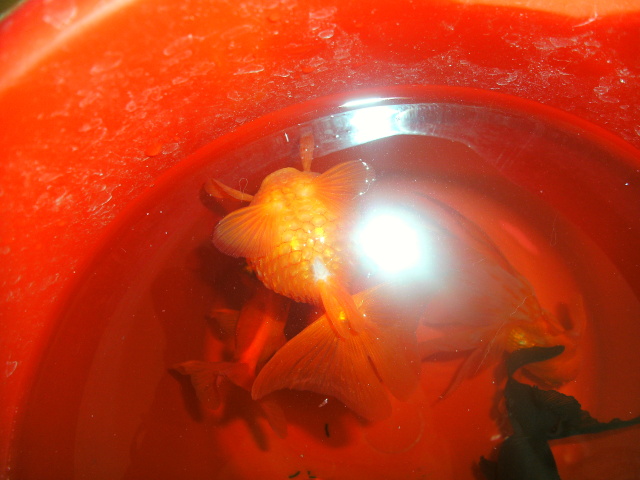 My Goldfish looks in pain.. :-(
Question
poorly fish..
I have just gone to clear my gol
My Goldfish looks in pain.. :-(
Question
poorly fish..
I have just gone to clear my gol
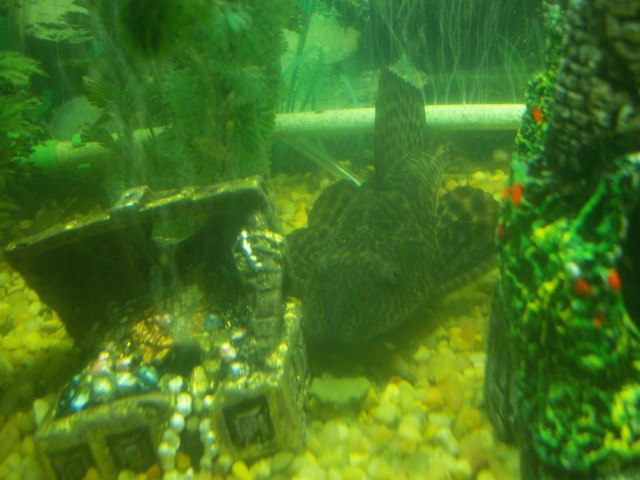 sick pleco please help
Questionsick pleco
QUESTION: Hello I have a 29ga
sick pleco please help
Questionsick pleco
QUESTION: Hello I have a 29ga
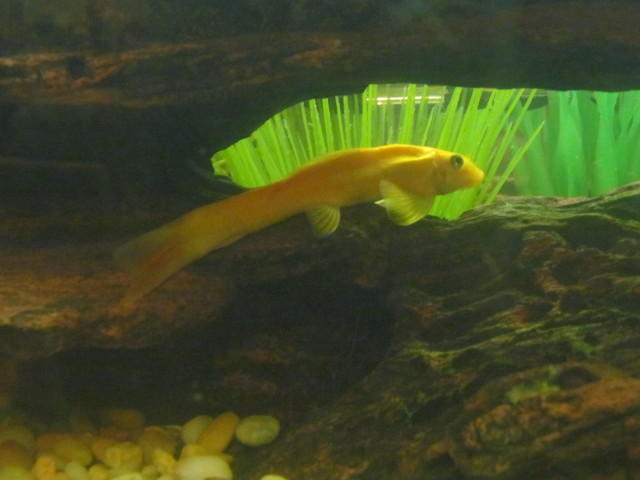 Chinese Algae Eater- Sick
Question
"Monster"
I have a Chinese Al
Chinese Algae Eater- Sick
Question
"Monster"
I have a Chinese Al
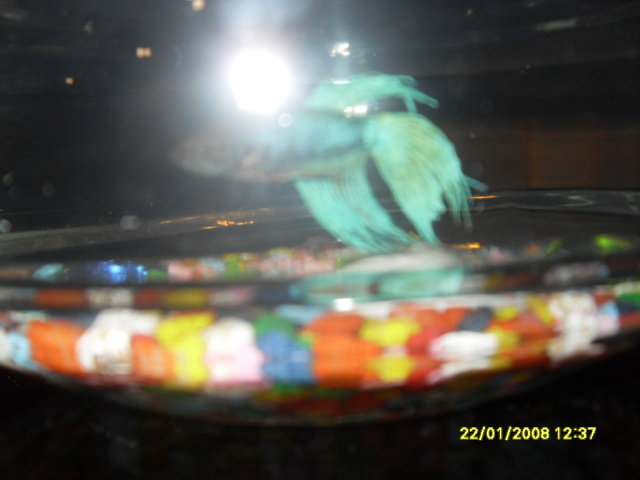 BETTA DEPRESSION EMERGENCY!
QuestionQUESTION: Hi, i have a new beta fish and he is
BETTA DEPRESSION EMERGENCY!
QuestionQUESTION: Hi, i have a new beta fish and he is
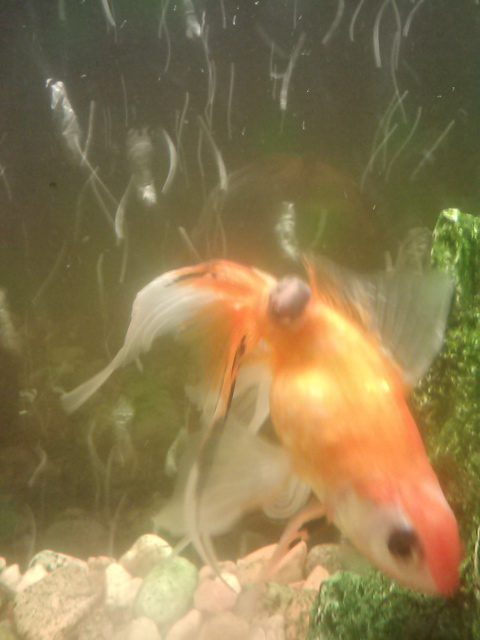 Lump on Fantail
Question
Fantail
We have a generic fantail goldf
Lump on Fantail
Question
Fantail
We have a generic fantail goldf